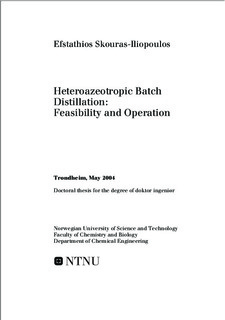| dc.contributor.author | Skouras-Iliopoulos, Efstathios | nb_NO |
| dc.date.accessioned | 2014-12-19T13:22:58Z | |
| dc.date.available | 2014-12-19T13:22:58Z | |
| dc.date.created | 2004-05-07 | nb_NO |
| dc.date.issued | 2004 | nb_NO |
| dc.identifier | 125131 | nb_NO |
| dc.identifier.isbn | 82-471-6302-0 | nb_NO |
| dc.identifier.uri | http://hdl.handle.net/11250/248105 | |
| dc.description.abstract | Separation of azeotropic mixtures is of great industrial importance and distillation is the dominating unit operation for such separations. However, the presence of azeotropes and non-idealities in the phase behaviour of such mixtures complicates the separation. In the pharmaceutical and fine/specialty chemical industry, the small-scale production and the requirement for flexibility indicates batch distillation as the best suited process. Among, various techniques to enhance distillation, heterogeneous azeotropic (heteroazeotropic) distillation is a very powerful and widely used one. Thus, there is a need for deeper understanding of the complex behaviour of the separation of heteroazeotropic mixtures in batch distillation columns.
This thesis is concerned with feasibility and operation aspects of heteroazeotropic distillation in different batch column configurations. Both conventional batch columns (rectifiers) and novel configurations (multivessel columns), with and without vapour bypass, are considered. The focus is on closed operations, without product removal. Batch time requirements for operation in all columns are provided for both zeotropic and heteroazeotropic mixtures. The advantages and drawbacks of each configuration are discussed and compared based on dynamic simulations. The configuration of the vapour stream in the middle vessel has an important effect on the time requirements of the process. Later on, a detailed analysis of the process is provided and previous published work concerning different operation modes and separation strategies is put under the right perspective. Simple control schemes are proposed for the practical operation of the columns and the realisation of the desired steady state results. The thesis ends with a detailed feasibility study of the process. The possibilities and limitations raised by different operational modes and separation strategies are illustrated. Simple feasibility conditions and entrainer selection rules are formulated that allow someone to investigate feasibility of the process in a systematic and comprehensive manner. | nb_NO |
| dc.language | eng | nb_NO |
| dc.publisher | Fakultet for naturvitenskap og teknologi | nb_NO |
| dc.relation.ispartofseries | Doktoravhandlinger ved NTNU, 1503-8181; 2004:47 | nb_NO |
| dc.relation.haspart | Skouras, S; Skogestad, S. Time (energy) requirements in closed batch distillation arrangements. Computers and Chemical Engineering. 28(5): 829-837, 2004. | nb_NO |
| dc.relation.haspart | Skouras, S; Skogestad, S. Separation of ternary heteroazeotropic mixtures in a closed multivessel batch distillation–decanter hybrid. Chemical Engineering and Processing. 43(3): 263-272, 2004. | nb_NO |
| dc.relation.haspart | Skouras, S; Skogestad, S. Time requirements for heteroazeotropic distillation in batch columns. Computers &and Chemical Engineering. 28(9): 1689-1700, 2004. | nb_NO |
| dc.relation.haspart | Skouras, S; Skogestad, S; Kiva, V. Analysis and control of heteroazeotropic batch distillation. AIChE Journal. 51(4): 1144-1157, 2005. | nb_NO |
| dc.relation.haspart | Skouras, S; Kiva, V; Skogestad, S. Feasible separations and entrainer selection rules for heteroazeotropic batch distillation. Chemical Engineering Science. 60(11): 2895-2909, 2005. | nb_NO |
| dc.subject | Chemical engineering | en_GB |
| dc.subject | TECHNOLOGY: Chemical engineering | en_GB |
| dc.title | Operation and feasibility of batch hetero-azeotropic distillation | nb_NO |
| dc.type | Doctoral thesis | nb_NO |
| dc.source.pagenumber | 173 | nb_NO |
| dc.contributor.department | Norges teknisk-naturvitenskapelige universitet, Fakultet for naturvitenskap og teknologi, Institutt for kjemisk prosessteknologi | nb_NO |
| dc.description.degree | dr.ing. | nb_NO |
| dc.description.degree | dr.ing. | en_GB |
